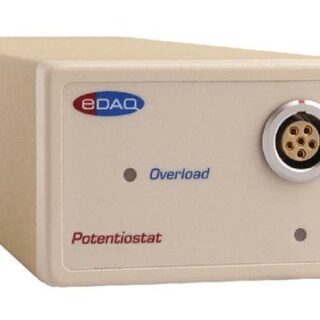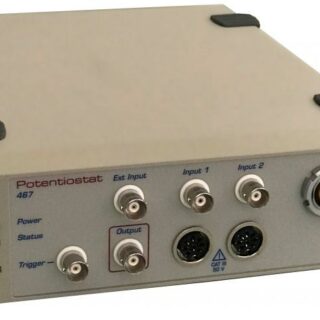Category
- Custom made glass products
- CUSTOMER SERVICES
- NEW PRODUCTS
- Sensors and electrodes
- Custom made and Modified Screen Printed Electrodes
- Stirrers
- Cables and connectors
- Cell
- Potentiostats
- Manual Screen Printer
- Minithermostat
- Pumps
- Accessories
- Kits & Sets
- Discounted SPEs (at a reduced price with visual defects/inconsistancies, but fully functional)
EA164 QuadStat
- Four-channel potentiostat 10mA to 200pA range
- Separate/common reference and auxiliary electrodes
- BiPotentiostat
- Ideal for amperometric biosensors, microbial fuel cells, photovoltaic materials and neurochemistry
The QuadStat is a software-controlled four-channel potentiostat with many Research Advantages (see below). Each channel can be used as a single three-electrode potentiostat. Alternatively two (bipotentiostat), three, or four working electrodes can be used in a single reaction chamber with a common reference and auxiliary electrode. Potential at each working electrode can be independently adjusted between ±2.5 V, or by using an external waveform generator to between ±10 V. The QuadStat can measure currents from pico- to milliamperes, making it ideal for amperometric biosensor research including use as a multichannel monitor for in vivo nitric oxide or dissolved oxgen sensors.
Two QuadStats can be ‘piggybacked’ to provide eight potentiostat channels.
By connecting the corresponding auxiliary and reference electrode leads, the QuadStat can be used as a four channel two-electrode (working and counter electrode) potentiostat. There is also a zero resistance ammeter (ZRA) mode of operation on each channel.
More information can be found through the link: https://www.edaq.com/EA164
Related products
-
EA362 Dual PicoStat
Read more- High sensitivity 2 channel potentiostat
- Bipotentiostat and 4-electrode modes of operation
The Dual PicoStat is a two channel high sensitivity potentiostat suitable for use with carbon fiber and ultramicroelectrodes for the monitoring of low current signals (down to picoameperes). It is commonly used for in vivo monitoring of dopamine by amperometry.
There are two potentiostat channels which enable the unit to also be used as a bipotentiostat (two working electrodes with a common reference and auxiliary electrode) so that dopamine levels can be monitored at two separate locations. Alternatively it can be used to perform duplicate experiments with separate samples, each with a working, reference and auxiliary electrode.
It can also be used as a 4-electrode voltage clamp (with two current passing and two voltage sensing reference electrodes) for studies of ionic transport across membranes or immiscible interfaces.
The Dual PicoStat is electrically isolated and is resistant to interference from neural stimulators, and ground loops. It is DC powered and can be used inside Faraday cages if required.
More information can be found through the link: https://www.edaq.com/EA362
-
EA163 Potentiostat
Read more- Modular potentiostat
- 4 modes: potentiostat, galvanostat, ammeter and voltmeter
This modular potentiostat is perfect for cyclic voltammetry and electroanalytical chemistry, and can use two (working and counter), or three (working, auxiliary and reference) electrodes. It can also operate as a galvanostat, ZRA (zero resistance ammeter), and high impedance voltmeter. It must be used together with any e-corder model.
The bandwidth of the EA163 is 100 kHz and so it is suitable for use with the Z100 Electrochemical Impedance Analyzer.
More information can be found through the link: https://www.edaq.com/EA163
-
ER467 High Current Potentiostat
Read more- Ideal for cyclic voltammetry, linear sweep and pulse techniques
- Potentiostat, galvanostat, ammeter and voltmeter modes
- Maximum 1 amp and ±10 V
- Expandable using isoPod amplifiers
- Four-electrode potentiostat
- Windows 7, 8 and 10 compatible
The ER467 Potentiostat System is ideal for cyclic, linear sweep, and most analytical pulse voltammetric experiments, either in the research or teaching laboratory. It also functions as a galvanostat, ZRA (zero resistance ammeter), and high impedance voltmeter (electrometer). Connection to a computer is via a USB cable.
More information can be found through the link: https://www.edaq.com/ER467
-
ER466 Integrated Potentiostat System
Read more- Ideal for cyclic voltammetry, linear sweep and pulse techniques
- Potentiostat, galvanostat, ammeter and voltmeter modes
- Maximum 100 mA and ±10 V
- Expandable using isoPod amplifiers
- High accuracy
- Windows 7, 8 and 10 compatible
The ER466 Integrated Potentiostat System is our most popular potentiostat model, being ideal for cyclic, linear sweep, and most analytical pulse voltammetric experiments, either in the research or teaching laboratory. It also functions as a galvanostat, ZRA (zero resistance ammeter), and high impedance voltmeter (electrometer). Connection to a computer is via a USB cable.
More information can be found through the link: https://www.edaq.com/ER466





